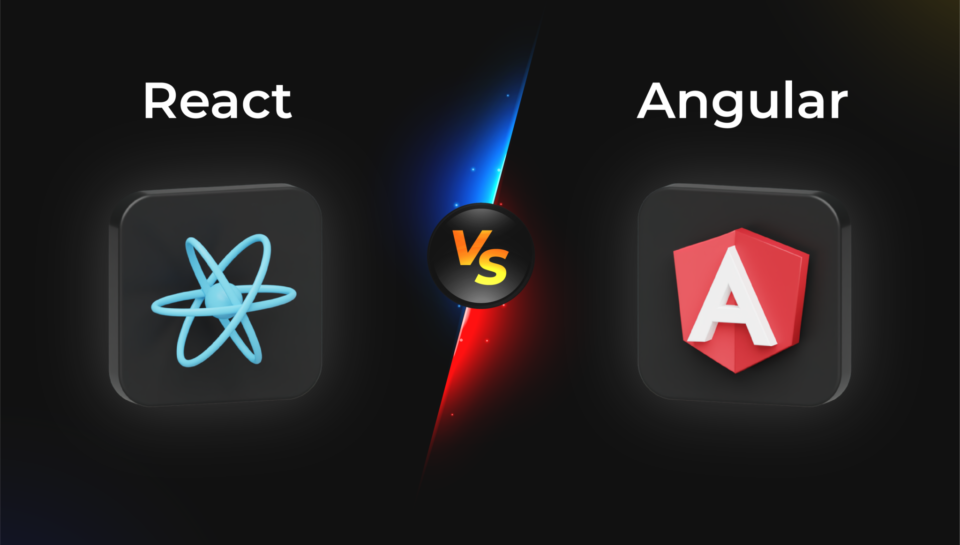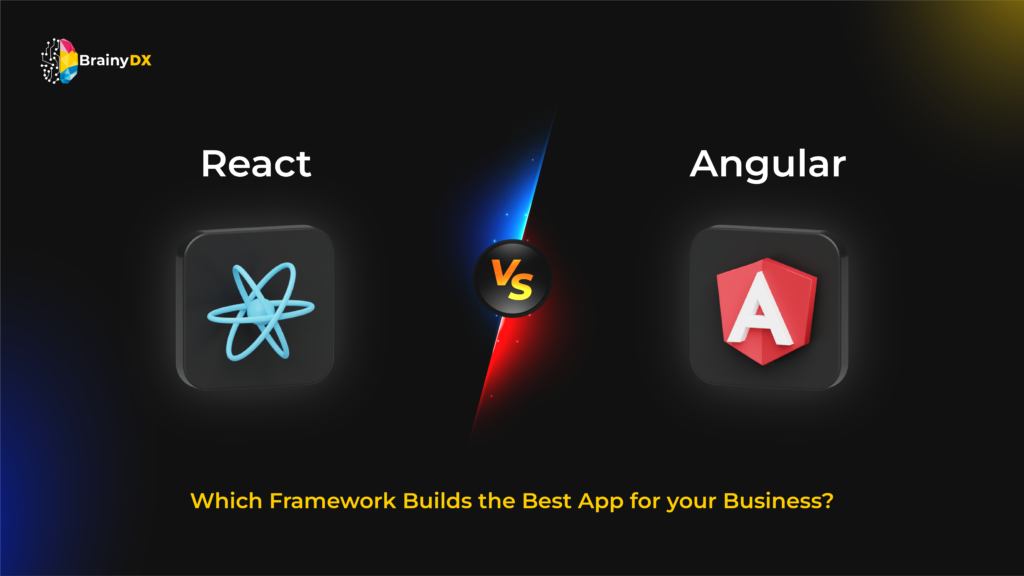
React vs Angular: Which JS Framework to Choose for Front-end Development?
React vs Angular: Which JS Framework to Choose for Front-end Development?


The ever-evolving landscape of web development offers a plethora of frameworks and libraries for frontend development. From Vue.js to Svelte, there’s something for everyone. But when it comes to the heavy hitters, React and Angular reign supreme. Both boast passionate communities, extensive resources, and the capability to create incredible user experiences. However, with distinct strengths and weaknesses, choosing the right one for your project can be a head-scratcher. This comprehensive guide delves into the core differences between React and Angular, empowering you to make an informed decision.
A Glimpse into React and Angular
Angular: Imagine a well-organized toolbox with all the necessary parts to build a house. That’s Angular – a full-fledged framework by Google. It uses TypeScript for type safety and enforces a clear separation of concerns using the Model-View-Controller(MVC) to keep your code clean. While it has a learning curve, Angular excels in complex enterprise applications.
React: Think of building blocks that snap together to create anything you can imagine. That’s React – a flexible library by Meta (formerly Facebook). It focuses on reusable UI components and utilizes a virtual DOM for efficient updates. React is easier to learn and is great for interactive features and UIs.
Diving Deeper into React vs Angular: Key Considerations
Now that we have a clear understanding of React and Angular, let’s delve into the nitty-gritty to help you make a well-informed decision:
- Learning Curve:
- Angular: With its MVC architecture and use of TypeScript, Angular offers a structured approach. This can lead to a steeper learning curve, especially for beginners unfamiliar with these concepts. However, the benefits of type safety and organized code pay off in the long run.
- React: On the other hand, React adopts a component-based architecture and leverages JavaScript, making it generally easier to grasp, particularly for those with a strong foundation in JavaScript. This allows developers to jump in and start building UIs quicker.
- Architecture:
- Angular: Enforces a structured MVC pattern for clear separation of concerns, promoting maintainable code for large applications.
- React: Leverages reusable components for a modular UI, allowing for rapid development and easier management of complex interfaces.
- Suitability for Different Projects:
- Angular: Ideal for complex SPAs and enterprise apps. Offers a structured approach and type safety for large, intricate projects.
- React: Perfect for dynamic UIs with frequent data changes. Component-based architecture promotes reusability and rapid UI development.
- Components and Size:
- Angular: Angular works on the Real DOM and follows the MVC pattern. This leads to a larger library size (approximately 92KB) compared to React. However, the use of real DOM can offer advantages in debugging and certain performance scenarios.
- React: React, on the other hand, works on a Virtual DOM, a lightweight copy or in-memory representation of the Real DOM. This virtual DOM allows React to efficiently identify changes and update only the necessary parts of the real DOM, potentially leading to faster performance for dynamic UIs. The size of React is also smaller (approximately 46KB) compared to Angular.
- Migration and Community Support:
- Angular: Angular releases new versions or updates every six months. This can sometimes lead to breaking changes, requiring developers to adapt their codebase. However, Angular is backed by Google and boasts a large and active community that provides extensive documentation and support. The current version of Angular is 15 (as of June 2024).
- React: React, maintained by Meta (formerly Facebook), has a different approach to updates. Upgrades in React are generally easier to handle than in Angular. Stability is a major concern for Meta, especially considering large companies like Netflix and Airbnb rely on React. React also has a vast and actively developed community. The current version of React is 18 (as of June 2024).
- Performance of React and Angular:
Both React and Angular are optimized for performance.- ReactJS: Due to its smaller bundle size and virtual DOM, React might have an edge for simpler applications. The virtual DOM allows for efficient updates, potentially leading to faster performance.
- Angular: Angular could outperform React in complex SPAs with optimizations like Ahead-of-Time (AOT) compilation and granular change detection. AOT compilation pre-compiles the application code before it’s deployed, reducing the amount of work needed in the browser and potentially improving load times. Granular change detection allows for more targeted updates within the application.
Note: It’s important to remember that the focus should be on developer experience and project needs when choosing a framework. Performance differences between React and Angular are often negligible for most web applications.
- When to Choose Angular
- Large-scale, enterprise applications: Angular’s structured approach, scalability, and emphasis on maintainable code through TypeScript make it ideal for complex projects requiring a robust foundation.
- SPAs with intricate workflows: Angular’s data binding and dependency injection streamline development for SPAs with substantial data flow and complex interactions.
- Focus on code maintainability: TypeScript in Angular enforces type safety, leading to more predictable code behavior and fewer errors in the long run, reducing maintenance costs.
- When to Choose ReactJS
- Simple and interactive web applications: React’s component-based architecture allows for rapid development of user interfaces, making it a great choice for building interactive web features and applications with a focus on UI.
- Projects requiring frequent UI updates: React’s virtual DOM ensures efficient rendering of dynamic UIs that constantly update, leading to a smoother user experience.
- Leveraging a vast ecosystem of libraries: The extensive collection of third-party libraries for ReactJS offers pre-built solutions for various functionalities, saving development time and effort.
Applications
- Angular: Due to its full-blown framework nature, Angular is most widely used for large-scale applications like video streaming apps or music instrument apps that require a structured approach and extensive features. Some notable companies using Angular include Google, Forbes, YouTube, Wix, and Telegram.
- React: React, being a library, is often a go-to choice for Single-Page Applications (SPAs) or applications where complex formatting isn’t a major requirement. Companies like Facebook, Instagram, Twitter, Airbnb, Netflix, Paypal, and Uber leverage React’s flexibility and vast ecosystem of libraries to build their applications.
How BrainyDX Can Help You Choose the Right Framework
BrainyDX is a digital transformation agency with a team of experienced front-end developers skilled in both React and Angular. We can help you choose the right framework for your project based on your specific requirements:
- Project Complexity: We will assess the complexity of your project and recommend the framework that offers the best balance of structure and flexibility.
- Team Skills: We will consider your development team’s skills and experience with JavaScript, TypeScript, and other relevant technologies
- Project Goals: We will discuss your project goals, including performance needs, development timeline, and long-term maintainability.
In Conclusion
The battle between React and Angular isn’t a zero-sum game. The optimal choice hinges on your project’s specific requirements. If you prioritize structure, scalability, and maintainability for complex applications, Angular might be the way to go. If flexibility, rapid UI development, and a vibrant community are your top concerns, ReactJS could be the better fit. Regardless of your decision, both Angular and ReactJS stand as powerful tools for crafting exceptional web applications. By carefully considering the factors mentioned above, you can make an informed decision that sets your project up for success.
Contact BrainyDX today to discuss your project requirements and how we can help you choose the right framework for your next application!


